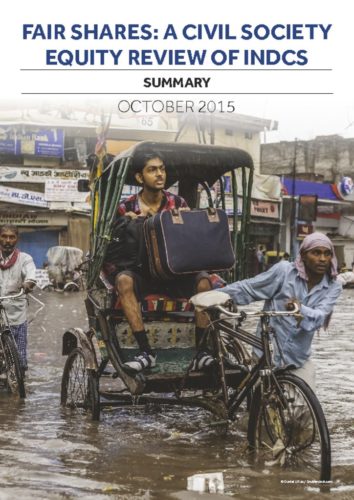PUBLICATION

Summary: Fair Shares: A civil society equity review of INDCs
The Fair Shares 2015 report was produced by Civil Society Equity Review, a global coalition of civil society organisations and movements. The report introduces a clear methodology for determining each country's 'Fair share' in line with the Climate convention's principles of equity.More info/Summary
The 2015 Fair shares report was the first in a series of reports produced by an unprecedented gathering of civil society organisations spanning climate justice and mainstream CSOs and movements. The report had a direct impact on the Paris summit negotiations. WhatNext? contributed extensively to the drafting of this and subsequent reports.
All reports and additional information about the Civil Society Equity Review project can be found at: http://civilsocietyreview.org/.
Summary of key findings, 2015 report
Our fair share assessments of the INDCS submitted by October 1, 2015, lead us to the following key findings:
Together, the commitments captured in INDCs will not keep temperatures below 2°C, much less 1.5°C, above pre-industrial levels. Even if all countries meet their INDC commitments, the world is likely to warm by a devastating 3°C or more, with a significant likelihood of tipping the global climate system into catastrophic runaway warming.
The current INDCs represent barely half of the reduction in emissions required by 2030, as shown in Figure 1. It must be noted that this itself relates to a very risky carbon budget. For a budget with a strong likelihood of keeping warming below 1.5°C or 2°C, the current INDCs would only meet a tiny fraction of what is needed. This means the fair shares presented here must be met. If anything, countries need to exceed these targets.
The ambition of all major developed countries fall well short of their fair shares, which include not only domestic action but also international fdinance. Those with the starkest gap between their climate ambition and their fair shares include:
- Russia: INDC represents zero contribution towards its fair share 9
- Japan: INDC represents about one tenth of its fair share United States: INDC represents about a fifth of its fair share
- European Union: INDC represents just over a fifth of its fair share
The majority of developing countries have made mitigation pledges that exceed or broadly meet their fair share, but they also have mitigation potential that exceeds their pledges and fair share – from the list of focus countries given in the next section, this includes Kenya, the Marshall Islands, China, Indonesia and India. Brazil’s INDC represents slightly more than two thirds of its fair share.
As stated above, even if countries’ pledges exceed their fair share, they will have to do more – with international support – for the world to reach a below 1.5°C or even 2°C pathway.
Most developed countries have fair shares that are already too large to fulfil exclusively within their borders, even with extremely ambitious domestic actions. In addition to very deep domestic reductions, the remainder of their fair shares must therefore be accomplished by enabling an equivalent amount of emissions reduction in developing countries through financing and other support. This accounts for almost half of the reductions that need to take place globally, which indicates the need for a vast expansion of international finance, technology and capacity-building support (Meansof Implementation). Moreover, this fact underscores the importance of a cooperative approach between developed and developing countries to enable scaled up ambition.
Although climate finance is critical for developed countries to deliver their fair shares, there is a striking lack of clear commitments. Massively scaled-up international public finance is required to support developing countries’ efforts, including finance to deliver the conditional offers from developing countries. In addition, significantly increased public climate finance is needed to meet the cost of adaptation, and to cover loss and damage in developing countries, particularly for the most vulnerable.

